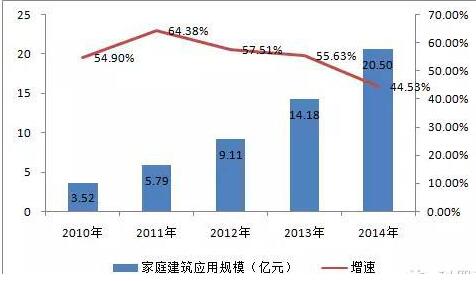In recent years, smog has erupted frequently in many provinces, seriously endangering people's health and daily life, and indoor air quality has also attracted widespread attention from all walks of life. According to a survey by CCTV, modern people spend 60% of their time indoors, and the figure is as high as 80% to 90% in cities. However, 96.25% of the rooms have indoor air pollution, and 89.56% of people hope to improve indoor air quality through air purification devices. The future development potential of China's indoor air quality market is huge. It is estimated that by 2018, the scale of my country's indoor air purification will reach 7.6 billion yuan.
2010-2014年新风系统在居家建筑领域的市场规模
The fresh air purification system is considered to be the safest and most effective means to quickly improve indoor air quality. The fresh air purification system exhausts the polluted indoor air through the exhaust port and the fan to the outdoor, so that the indoor negative pressure is formed. After the outdoor fresh air is purified by the filter device, it enters the room through the air inlet, so that the indoor personnel can breathe to a high level. Quality fresh air. Compared with the air purifier with a single air circulation, the fresh air purification system has the dual functions of purification and ventilation at the same time, which is more healthy and comfortable.
The fresh air system has been widely used in developed countries in Europe and America for more than 40 years, and the household penetration rate is as high as 96.56%. Japan has corresponding regulations expressly stipulating that the installation of fresh air systems is mandatory. After 2003, the installation rate of fresh air systems in buildings in Japan is 100%. The popularity of fresh air systems in my country is only in its infancy, and the current penetration rate of fresh air systems in households is less than 1%.
In recent years, the hazards of haze to health have been widely known to the public, and the treatment of the atmosphere will be a long-term process. Under this environmental background, the fresh air purification system has ushered in the best time for market introduction. The next few years will be the period of rapid growth of the fresh air purification system industry. In 2014, the overall market revenue of my country's IQA was 3.3 billion U.S. dollars, and it will increase to 5.6 billion U.S. dollars by 2020, with a compound annual growth rate of 8.8%. The fresh air system industry has huge potential. It is reported that the potential of the fresh air purification system in the civilian market is at least 168 million units, becoming an emerging consumption hotspot after real estate, automobiles, and electronic communications.
According to the follow-up survey data of Hangzhou Kali Technology (Stock Abbreviation: Kali Technology Securities Code: 837238) AIQC Laboratory since 2005, before 2008, the application rate of fresh air purification system in residential buildings, public buildings and industrial buildings Not high. As people's awareness of the hazards of smog deepens, the fresh air purification system has begun to become the standard configuration of high-end real estate. In 2014, the market share of fresh air purification systems in high-end residential buildings reached 2.05 billion, a year-on-year increase of 44.53%; the market share of fresh air systems in public buildings such as hospitals, hotels, and office buildings was 2.7 billion yuan, a year-on-year increase of 34.17%.
The attractive market has also made the fresh air system industry unprecedentedly prosperous. Brands in the air purification industry rose from 151 in 2013 to 556 in 2014. Due to the lack of a unified industry standard, brands are mixed, purification principles are varied, and purification effects vary. This kind of chaos in the industry was gradually contained after the introduction of the "New National Standard for Air Purifiers". On September 15, 2015, the national standard GB/T18801-2015 "Air Purifier" was officially announced, and it was officially implemented on March 1, 2016. The introduction of the "New National Standard for Air Purifiers" has accelerated the reshuffle of the fresh air system industry, effectively restricted some OEM manufacturers, eliminated a number of unqualified enterprises, and raised the industry's entry barriers.
The "New National Standard for Air Purifiers" also breathed a sigh of relief for scientific research and technology companies that really focus on indoor air quality research. Kali Intelligent Technology, located in Hangzhou, has been engaged in the research of indoor air composition and separation (purification) basic materials and technologies as early as 2005. In 2007, it invested in the establishment of a European technical standard air purification CADR test laboratory to develop a full physical purification method. FILTECH fresh air system http://www.filtech.cn. The promulgation and implementation of the "New National Standard for Air Purifiers" frees such a technology research and development company from "hand-to-hand" in disorderly industry competition, but instead focuses on improving its technological level and responding to healthy market competition.
The standardization of the fresh air purification system industry is conducive to the healthy development of the industry. In the next few years, the fresh air purification system industry will enter a period of rapid growth. It is predicted that in the next five years, the fresh air purification system industry will account for about 1.5% of China's GDP. As Chinese residents pay more and more attention to health, the fresh air purification system will have a huge and infinite market in China. The fresh air purification system industry will be one of the ten fastest-growing industries in the next decade.



